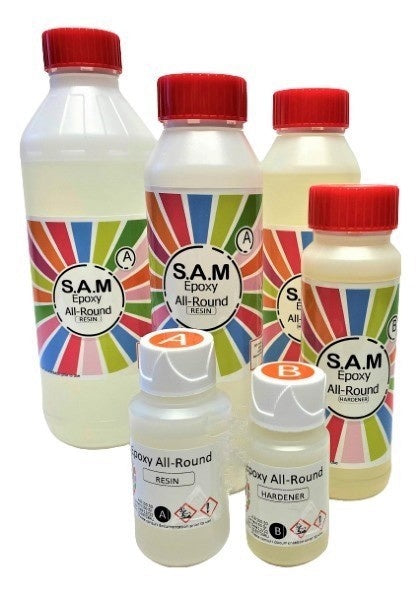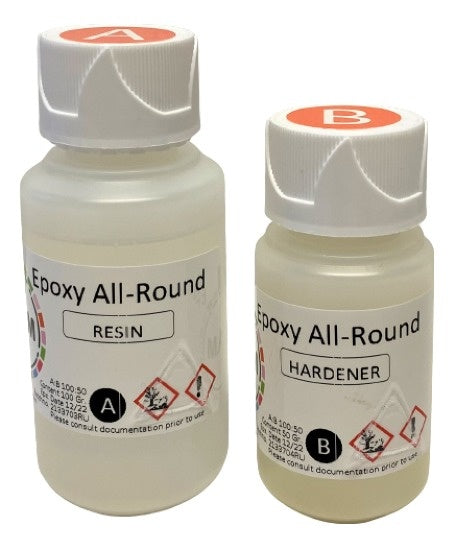Epoxy for laminating
-


Huismerk - SAMAll-Round Epoxy Casting Resin
€10,50€8,68
This All-Round epoxy resin is widely used in boat building and manufacturing. Because this resin can be used as laminating resin, glue, casting resin and coating, it is widely applicable. This epoxy can be processed in combination with wood, concrete,...
-


Eli-Chem Resins UK LTDUltraCast XT Epoxyresin Crystal Clear heat resistant till 95°C
€29,99€24,79
Ultra Cast XT is an epoxy resin which once cured gives a very clear results with a heat resistance up to 90°C. Ultra Cast XT is an epoxy resin that cures at room temperature and gives a very transparent end...
-


Huismerk - SAMLaminating Epoxy Resin, 0.1 to 2 cm thick lamination
€23,55€19,46
The low viscosity (very fluid) of this clear epoxy casting resin makes it suitable for detailed casting of small objects and is suitable for 0.1 cm castings. up to 2 cm thickness. This epoxy resin is very suitable for pouring...
Epoxy lamination with fiberglass, carbon & Kevlar
Laminating epoxy produces strong, durable laminates with excellent adhesion and low shrinkage. The process is similar to polyester (same rollers/technique), but epoxy generally adheres better and has a lower odor. Pay attention to the pot life: for vertical work and large surfaces, choose a suitable fast- or slow-hardening hardener.
Why laminating epoxy?
- ✓ Strong adhesion to substrates and between layers; less delamination
- ✓ Low viscosity and good wet-out of glass, carbon and aramid fabrics
- ✓ High mechanical performance ; optional post-cure for higher Tg/heat resistance
- ✓ Marine-ready: ideal for boat building/repair and composite parts
Tip: Epoxy gels more slowly than many polyesters. Use the correct pot life and temperature (approx. 18–25°C) to prevent sagging.
Compatibility with fibers & mats
- → Glass fiber (woven/UD), carbon and kevlar/aramid: excellent for epoxy
- → CSM (chopped strand mat): Use only powder-bonded CSM with epoxy. Emulsion-bonded CSM is for polyester/vinyl ester.
- → Filling can: add conductive or insulating fillers to control properties
Choose your laminating system
| Scenario | Featured Properties | What to look out for |
|---|---|---|
| Hand lay-up (general) | Low to medium viscosity, standard hardener | Work at 18–25°C; minimize air entrapment |
| Vacuum bagging / infusion | Very low viscosity, longer pot life | Flow through the stack plan; controlled heating |
| Vertical lamination / quick fix | Fast hardener, thixotropic additive possible | Note sag; thin layers in multiple passes |
| Marine epoxy (boat/canoe/surf) | Good adhesion to wood/fiberglass, moisture resistant | Possibly post-cure and suitable coating/UV protection |
| High Tg / heat resistant | System with higher glass transition temperature | Post-treatment (post-cure) according to datasheet |
Processing methods
Hand Lay-up
- Position fabrics dry; apply epoxy with roller/brush influences
- Remove air with a deaeration roller; work in thin layers
- Apply the next coat within the chemical bonding time
Vacuum Bagging / Infusion
- Stacking plan: clean mold, peel ply, tear-woven felt, flow media, and vacuum foil
- Low viscosity resin with extended pot life for good flow
- Check leakage and cure schedule; optional post-cure
Practical tips
- Preparation : Clean and degrease the mold/surface; cut away loose fibers.
- → Mixing: weigh accurately, including the edges and bottom; if necessary, mix again in a second beaker
- → Temperature: 18–25°C and draught-free; higher T = shorter pot life
- → Resin/fiber ratio: guideline value for hand lay-up fiberglass approx. 1.0–1.3× fiber weight
- → Safety: gloves, goggles, ventilation; follow TDS/SDS
FAQ - Laminating epoxy
What is the advantage of epoxy over polyester when laminating?
Better adhesion, lower shrinkage, and often higher mechanical performance; however, a longer pot life/gel time and higher raw material prices.
Can I use CSM with epoxy?
Yes, but choose powder-bound CSM. Emulsion-bound CSM is intended for polyester/vinyl ester (styrene dissolves the binder).
Which pot life do I choose?
Small/thick sections or warm weather → longer pot life. Fast repairs/vertical parts → shorter pot life. Adjust batch size and ambient temperature accordingly.
Do I need to post-cure?
Only if you need a higher Tg/heat resistance or maximum properties. Follow the recommended post-treatment schedule.
Does epoxy bond to wood, carbon and kevlar?
Yes. Ensure surfaces are clean, dust- and grease-free, and there is sufficient resin impregnation (wet-out).
Advice & order
Are you unsure whether to choose hand lay-up or vacuum bagging, or do you need a marine epoxy with a higher Tg? We'll help you choose the right epoxy laminating resin and hardener.







